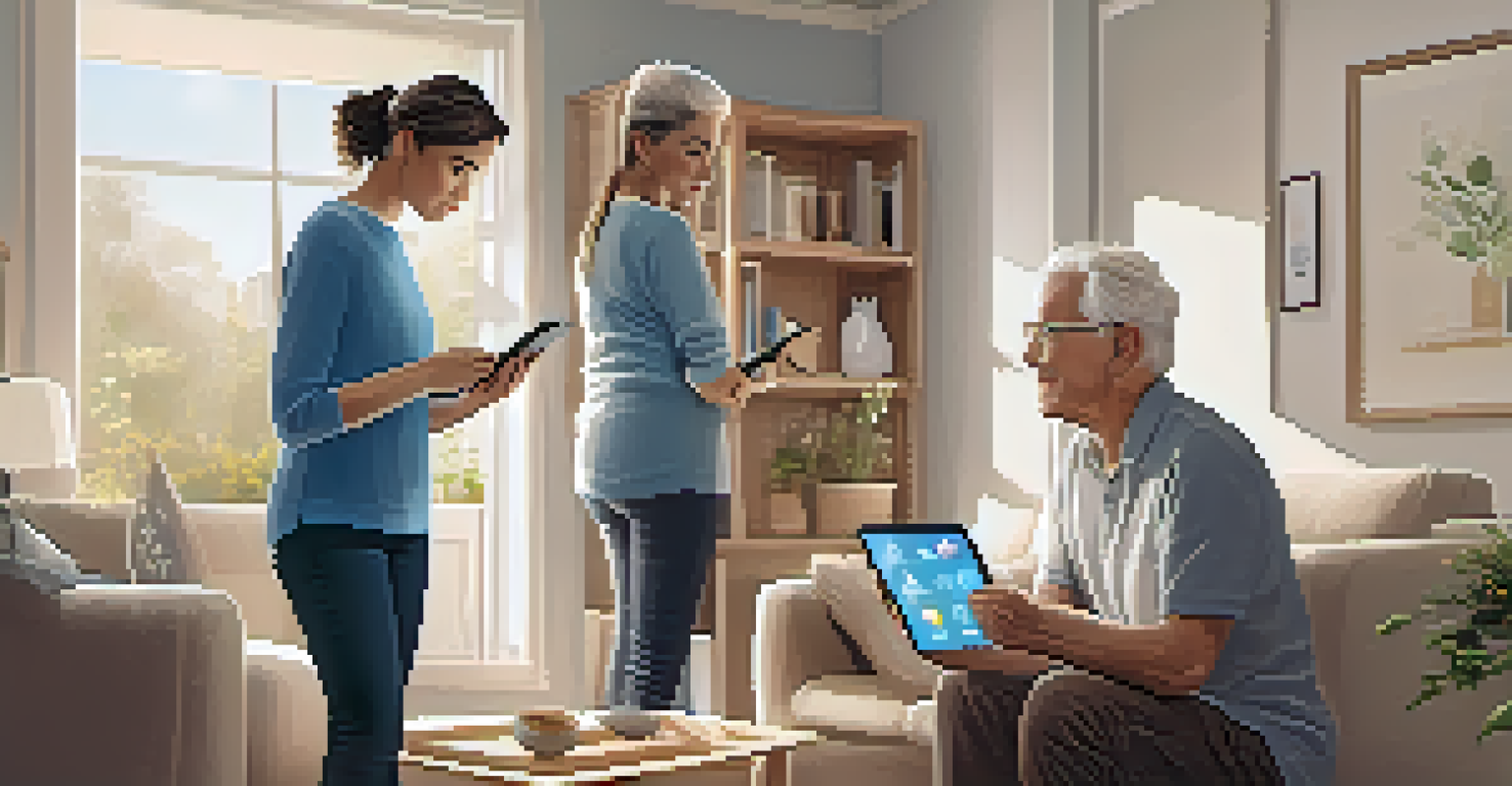Home Automation for Elderly and Disabled Individuals

Understanding Home Automation for Seniors and Disabled
Home automation refers to the use of technology to control household systems like lighting, heating, and security remotely. For elderly and disabled individuals, this technology can significantly enhance their quality of life by promoting independence and safety. Imagine being able to adjust the thermostat from your phone or have lights turn on automatically as you enter a room.
Technology is best when it brings people together.
These systems often include voice-activated devices, smart speakers, and apps that allow users to manage their homes without needing to physically interact with traditional switches or controls. This is particularly beneficial for those with mobility challenges, as it minimizes the need for strenuous movements or reaching.
Ultimately, home automation is about making life easier and more comfortable. By integrating these technologies into their daily routines, seniors and disabled individuals can enjoy greater autonomy and peace of mind.
Key Benefits of Home Automation for Seniors
One of the primary benefits of home automation for seniors is safety. Smart home devices can monitor for potential hazards like smoke, carbon monoxide, or even intruders, sending alerts directly to their smartphones or emergency contacts. This added layer of security can be incredibly reassuring for both the individual and their loved ones.

Another significant advantage is the convenience that comes with automation. Tasks that may have been difficult, such as adjusting blinds or turning on the oven, can now be accomplished with simple voice commands or through mobile apps. This ease of access can help reduce feelings of frustration and dependence on caregivers.
Enhancing Safety and Independence
Home automation significantly improves safety and promotes independence for seniors and disabled individuals through remote monitoring and control.
Additionally, home automation can promote health and well-being. Systems can be set up to remind individuals to take medication or to encourage physical activity by controlling exercise equipment. These small nudges can make a big difference in maintaining a healthy lifestyle.
Popular Home Automation Tools for Seniors
There are numerous home automation tools available that cater specifically to the needs of seniors and disabled individuals. Voice-activated assistants, like Amazon Alexa and Google Assistant, are particularly popular as they offer hands-free control of various devices. Imagine simply saying, 'Turn on the lights,' instead of fumbling for a switch.
The greatest danger in times of turbulence is not the turbulence; it is to act with yesterday's logic.
Smart thermostats are another great example. They can learn a user’s preferences over time, adjusting temperatures automatically to ensure comfort without any manual effort. This is especially useful for those with limited mobility who may struggle with traditional dials.
Moreover, smart doorbells and security cameras allow individuals to see who is at their door without getting up, offering peace of mind and security. These tools not only enhance safety but also help seniors feel more connected to their homes.
Challenges in Implementing Home Automation
While the benefits of home automation are clear, there are challenges to consider. One of the biggest hurdles is the initial cost of purchasing and installing smart devices. Many seniors are on fixed incomes, so budgeting for these technologies can be a concern.
Another challenge is the potential for technological barriers. Some seniors may feel overwhelmed by the idea of using new gadgets and may need assistance in understanding how they work. This can lead to frustration and reluctance to adopt these helpful tools.
Accessibility Through Smart Devices
Voice-activated assistants and smart tools simplify everyday tasks, making technology more accessible for those with mobility challenges.
Additionally, it’s vital to ensure that the chosen systems are user-friendly. Complicated interfaces can defeat the purpose of making life easier, so selecting devices designed with seniors in mind is key to successful implementation.
Integrating Smart Devices into Daily Life
Integrating smart devices into daily life doesn’t have to be complicated. Start small by introducing one or two devices that address immediate needs, such as smart lights or a voice assistant. This gradual approach allows individuals to get comfortable with technology without feeling overwhelmed.
It's also beneficial to involve family members in the process. They can help set up devices and provide ongoing support, which can ease the transition for seniors. Think of it as a family project, where everyone contributes to creating a more comfortable living environment.
Moreover, regular training sessions can be helpful. Setting aside time to practice using the devices can enhance confidence and ensure seniors feel empowered rather than intimidated by the technology.
The Role of Caregivers in Home Automation
Caregivers play a crucial role in the successful implementation of home automation for seniors. They can assess the specific needs of the individual and recommend suitable devices that will genuinely enhance their quality of life. A caregiver’s insight can make a significant difference in choosing the right tools.
Furthermore, caregivers can facilitate training sessions to help seniors learn how to use these devices effectively. By being patient and encouraging, they can help alleviate any fears of technology that the elderly might have.
Support from Caregivers is Key
Caregivers play a crucial role in the successful implementation of home automation, providing training and ongoing support to ensure effectiveness.
Lastly, caregivers can monitor the effectiveness of the automation systems and make adjustments as needed. This ongoing support ensures that the technology remains beneficial and tailored to the individual’s evolving needs.
Looking Ahead: The Future of Home Automation
As technology continues to evolve, the future of home automation for seniors looks promising. Innovations such as artificial intelligence and machine learning are paving the way for even smarter systems that can anticipate needs and preferences. Imagine a home that adjusts itself to your routine without you having to lift a finger.
Moreover, the rise of wearable technology will likely complement home automation. Devices that monitor health metrics can work in tandem with smart home systems to provide real-time updates and alerts, keeping both seniors and caregivers informed.

Ultimately, the goal is to create a more inclusive environment that embraces technology to enhance the lives of seniors and disabled individuals. With ongoing advancements, the possibilities are endless, offering hope for a future where independence is within everyone's reach.